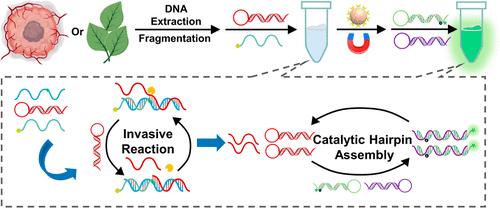当前位置:
X-MOL 学术
›
Anal. Chem.
›
论文详情
Our official English website, www.x-mol.net, welcomes your
feedback! (Note: you will need to create a separate account there.)
Hairpin-Empowered Invasive Reaction Combined with Catalytic Hairpin Assembly Cascade Amplification for the Specific Detection of Single-Nucleotide Polymorphisms
Analytical Chemistry ( IF 6.7 ) Pub Date : 2024-06-12 , DOI: 10.1021/acs.analchem.4c01049 Yunshan Zhang 1 , Shijie Xu 1, 2 , Ma Luo 1 , Jian Chen 2 , Lanyue Wang 1, 2 , Fang Yang 1, 2 , Jing Ye 1 , Jichong Liu 1 , Bingxiao He 1 , Lin Weng 3 , Shuang Li 4 , Diming Zhang 1
Analytical Chemistry ( IF 6.7 ) Pub Date : 2024-06-12 , DOI: 10.1021/acs.analchem.4c01049 Yunshan Zhang 1 , Shijie Xu 1, 2 , Ma Luo 1 , Jian Chen 2 , Lanyue Wang 1, 2 , Fang Yang 1, 2 , Jing Ye 1 , Jichong Liu 1 , Bingxiao He 1 , Lin Weng 3 , Shuang Li 4 , Diming Zhang 1
Affiliation

|
Single-nucleotide polymorphism (SNP) is widely used in the study of disease-related genes and in the genetic study of animal and plant strains. Therefore, SNP detection is crucial for biomedical diagnosis and treatment as well as for molecular design breeding of animals and plants. In this regard, this article describes a novel technique for detecting SNP using flap endonuclease 1 (FEN 1) as a specific recognition element and catalytic hairpin assembly (CHA) cascade reaction as a signal amplification strategy. The mutant target (MT) was hybridized with a biotin-modified upstream probe and hairpin-type downstream probe (DP) to form a specific three-base overlapping structure. Then, FEN 1 was employed for three-base overlapping structure-specific recognition, namely, the precise SNP site identification and the 5′ flap of DP dissociation. After dissociation, the hybridized probes were magnetically separated by a streptavidin–biotin complex. Especially, the ability to establish such a hairpin-type DP provided a powerful tool that could be used to hide the cut sequence (CS) and avoid false-positive signals. The cleaved CS initiated the CHA reaction and allowed superior fluorescence signal generation. Owing to the high specificity of FEN 1 for single base recognition, only the MT could be distinguished from the wild-type target and mismatched DNA. Owing to the dual signal amplification, as low as 0.36 fM MT and 1% mutation abundance from the mixtures could be detected, respectively. Furthermore, it could accurately identify SNPs from human cancer cells, as well as soybean leaf genome extracts. This strategy paves the way for the development of more precise and sensitive tools for diagnosing early onset diseases as well as molecular design breeding tools.
中文翻译:

发夹授权侵入反应与催化发夹组装级联扩增相结合,用于单核苷酸多态性的特异性检测
单核苷酸多态性(SNP)广泛应用于疾病相关基因的研究以及动植物品系的遗传研究。因此,SNP检测对于生物医学诊断和治疗以及动植物的分子设计育种至关重要。在这方面,本文描述了一种检测 SNP 的新技术,使用瓣状核酸内切酶 1 (FEN 1) 作为特异性识别元件,并使用催化发夹组装 (CHA) 级联反应作为信号放大策略。突变靶标(MT)与生物素修饰的上游探针和发夹型下游探针(DP)杂交,形成特定的三碱基重叠结构。然后,利用FEN 1进行三碱基重叠结构特异性识别,即精确的SNP位点识别和DP解离的5'襟翼。解离后,杂交探针被链霉亲和素-生物素复合物磁性分离。特别是,建立这种发夹型 DP 的能力提供了一个强大的工具,可用于隐藏切割序列 (CS) 并避免假阳性信号。裂解的 CS 引发 CHA 反应并产生优异的荧光信号。由于FEN 1对单碱基识别的高度特异性,只有MT才能与野生型靶标和错配DNA区分开来。由于双重信号放大,可以分别检测到混合物中低至 0.36 fM MT 和 1% 的突变丰度。此外,它还可以准确识别人类癌细胞以及大豆叶基因组提取物中的 SNP。这一策略为开发更精确、更灵敏的早发疾病诊断工具以及分子设计育种工具铺平了道路。
更新日期:2024-06-12
中文翻译:

发夹授权侵入反应与催化发夹组装级联扩增相结合,用于单核苷酸多态性的特异性检测
单核苷酸多态性(SNP)广泛应用于疾病相关基因的研究以及动植物品系的遗传研究。因此,SNP检测对于生物医学诊断和治疗以及动植物的分子设计育种至关重要。在这方面,本文描述了一种检测 SNP 的新技术,使用瓣状核酸内切酶 1 (FEN 1) 作为特异性识别元件,并使用催化发夹组装 (CHA) 级联反应作为信号放大策略。突变靶标(MT)与生物素修饰的上游探针和发夹型下游探针(DP)杂交,形成特定的三碱基重叠结构。然后,利用FEN 1进行三碱基重叠结构特异性识别,即精确的SNP位点识别和DP解离的5'襟翼。解离后,杂交探针被链霉亲和素-生物素复合物磁性分离。特别是,建立这种发夹型 DP 的能力提供了一个强大的工具,可用于隐藏切割序列 (CS) 并避免假阳性信号。裂解的 CS 引发 CHA 反应并产生优异的荧光信号。由于FEN 1对单碱基识别的高度特异性,只有MT才能与野生型靶标和错配DNA区分开来。由于双重信号放大,可以分别检测到混合物中低至 0.36 fM MT 和 1% 的突变丰度。此外,它还可以准确识别人类癌细胞以及大豆叶基因组提取物中的 SNP。这一策略为开发更精确、更灵敏的早发疾病诊断工具以及分子设计育种工具铺平了道路。





















































 京公网安备 11010802027423号
京公网安备 11010802027423号